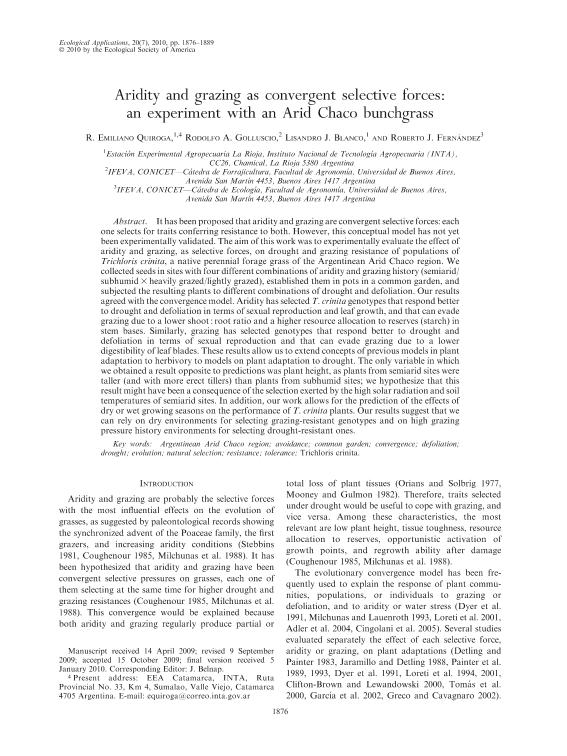Mostrar el registro sencillo del ítem
dc.contributor.author
Quiroga, R. Emiliano
dc.contributor.author
Golluscio, Rodolfo

dc.contributor.author
Blanco, Lisandro Javier

dc.contributor.author
Fernández, Roberto J.
dc.date.available
2019-04-08T18:47:07Z
dc.date.issued
2010-10
dc.identifier.citation
Quiroga, R. Emiliano; Golluscio, Rodolfo; Blanco, Lisandro Javier; Fernández, Roberto J.; Aridity and grazing as convergent selective forces: An experiment with an Arid Chaco bunchgrass; Ecological Society of America; Ecological Applications; 20; 7; 10-2010; 1876-1889
dc.identifier.issn
1051-0761
dc.identifier.uri
http://hdl.handle.net/11336/73439
dc.description.abstract
It has been proposed that aridity and grazing are convergent selective forces: each one selects for traits conferring resistance to both. However, this conceptual model has not yet been experimentally validated. The aim of this work was to experimentally evaluate the effect of aridity and grazing, as selective forces, on drought and grazing resistance of populations of Trichloris crinita, a native perennial forage grass of the Argentinean Arid Chaco region. We collected seeds in sites with four different combinations of aridity and grazing history (semiarid/subhumid × heavily grazed/lightly grazed), established them in pots in a common garden, and subjected the resulting plants to different combinations of drought and defoliation. Our results agreed with the convergence model. Aridity has selected T. crinita genotypes that respond better to drought and defoliation in terms of sexual reproduction and leaf growth, and that can evade grazing due to a lower shoot : root ratio and a higher resource allocation to reserves (starch) in stem bases. Similarly, grazing has selected genotypes that respond better to drought and defoliation in terms of sexual reproduction and that can evade grazing due to a lower digestibility of leaf blades. These results allow us to extend concepts of previous models in plant adaptation to herbivory to models on plant adaptation to drought. The only variable in which we obtained a result opposite to predictions was plant height, as plants from semiarid sites were taller (and with more erect tillers) than plants from subhumid sites; we hypothesize that this result might have been a consequence of the selection exerted by the high solar radiation and soil temperatures of semiarid sites. In addition, our work allows for the prediction of the effects of dry or wet growing seasons on the performance of T. crinita plants. Our results suggest that we can rely on dry environments for selecting grazing-resistant genotypes and on high grazing pressure history environments for selecting drought-resistant ones.
dc.format
application/pdf
dc.language.iso
eng
dc.publisher
Ecological Society of America

dc.rights
info:eu-repo/semantics/openAccess
dc.rights.uri
https://creativecommons.org/licenses/by-nc-sa/2.5/ar/
dc.subject
Argentinean Arid Chaco Region
dc.subject
Avoidance
dc.subject
Common Garden
dc.subject
Convergence
dc.subject
Defoliation
dc.subject
Drought
dc.subject
Evolution
dc.subject
Natural Selection
dc.subject
Resistance
dc.subject
Tolerance
dc.subject
Trichloris Crinita
dc.subject.classification
Otras Producción Animal y Lechería

dc.subject.classification
Producción Animal y Lechería

dc.subject.classification
CIENCIAS AGRÍCOLAS

dc.title
Aridity and grazing as convergent selective forces: An experiment with an Arid Chaco bunchgrass
dc.type
info:eu-repo/semantics/article
dc.type
info:ar-repo/semantics/artículo
dc.type
info:eu-repo/semantics/publishedVersion
dc.date.updated
2019-03-08T20:19:06Z
dc.journal.volume
20
dc.journal.number
7
dc.journal.pagination
1876-1889
dc.journal.pais
Estados Unidos

dc.description.fil
Fil: Quiroga, R. Emiliano. Instituto Nacional de Tecnología Agropecuaria; Argentina
dc.description.fil
Fil: Golluscio, Rodolfo. Universidad de Buenos Aires. Facultad de Agronomía; Argentina. Consejo Nacional de Investigaciones Científicas y Técnicas; Argentina
dc.description.fil
Fil: Blanco, Lisandro Javier. Instituto Nacional de Tecnología Agropecuaria; Argentina
dc.description.fil
Fil: Fernández, Roberto J.. Universidad de Buenos Aires. Facultad de Agronomía; Argentina
dc.journal.title
Ecological Applications

dc.relation.alternativeid
info:eu-repo/semantics/altIdentifier/doi/http://dx.doi.org/10.1890/09-0641.1
dc.relation.alternativeid
info:eu-repo/semantics/altIdentifier/url/https://esajournals.onlinelibrary.wiley.com/doi/abs/10.1890/09-0641.1
Archivos asociados
